A refuge for pollinators: A case study of establishing large-scale pollinator habitat on marginal farmland using federal funds
Establishing a pollinator refuge through the National Resource Conservation Service Environmental Quality Incentives Program in southern Michigan.

There are many ways to support pollinator health by planting flowers. This case study provides one example of establishing pollinator habitat in southern Michigan by participating in the National Resource Conservation Service Environmental Quality Incentives Program.
Background
In this case study, Meghan Milbrath, a beekeeper and assistant professor in the Department of Entomology at Michigan State University, used a federal program to fund the restoration of 26 acres of marginal farmland that is owned by her relative in Jackson County, Michigan. Milbrath had two main motivations for creating the pollinator habitat: first, she wanted to promote a healthy pollinator environment for bees (both her honey bees and the native bees), and second, she wanted to go through the process of applying for a federal grant so that she could help others through the process in the future. Creating this habitat would allow her to learn the process, create a beneficial habitat, and promote pollinator health.
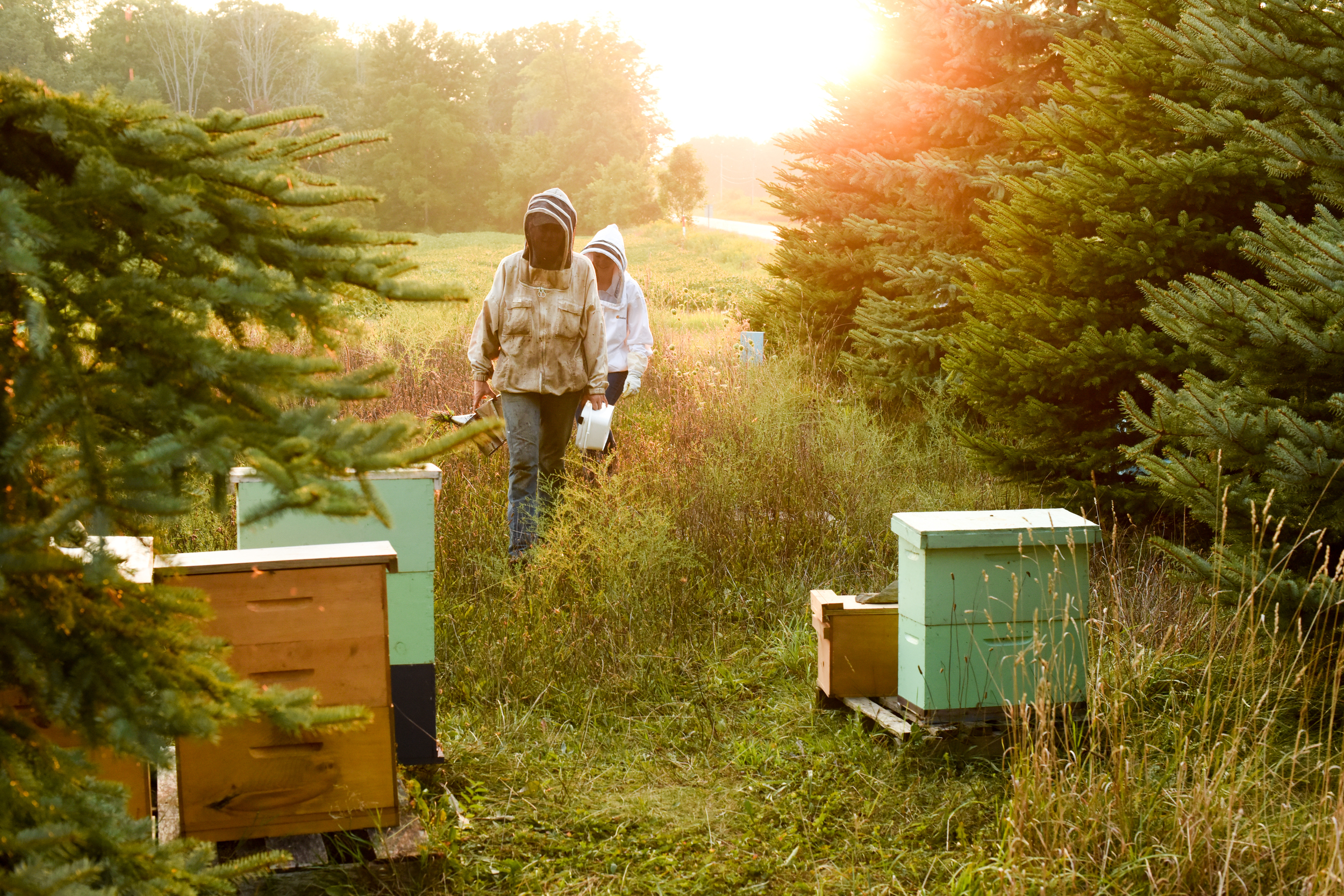
Goals
In her work at Michigan State University Extension, Milbrath finds herself advocating to others about doing their part to help improve habitats where and when they can, so she wanted to do a bit more herself to support pollinators. Even though she did not own the land, she could put in the time and effort needed to create pollinator habitat.
Timeline
The idea of the project began at the end of 2014. Milbrath established communication with the Farm Service Agency (FSA) office in January 2015, and she was able to plant and receive the funds in 2016 and 2017. This timeline will vary for each person, as everyone is in different situations, depending on the paperwork and requirements for each project.
2014
Site determination
Milbrath did not own any land herself but had a family member who farmed about 1,200 acres in Jackson County in a corn-soy rotation. In 2014, the farmer mentioned that the sandy part of one 80-acre parcel was too steep and sandy and did not feel worth planting in the upcoming season, as the corn planted on that portion did not yield like the rest of the property. The sandy hill bordered a muck portion that had also become difficult to plant as it would not dry out in time for planting most years. Milbrath suggested to the farmer to take the undesirable farmland and restore it to grassland and wetland, and he was quick to agree, if she would do all the work. The site is the back 26 acres of an 80-acre parcel, and includes an eight-acre sandy hill, 16 acres of muck wetland, and a two-acre woodlot in the middle.
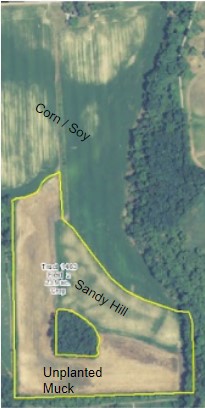
2015
Milbrath started by obtaining as much information as possible, using multiple resources. Having worked and volunteered in prairie restoration previously, Milbrath had a basic understanding of the necessary maintenance of grassland and wetland sites, but installation would be a whole new experience for her. She received as much help from others as possible, reaching out to experts at the National Resource Conservation Service (NRCS), Heartland Restoration Services (the seed company that she would ultimately buy from), and the Xerces Society. Crucial resources included Pollinator Biology and Habitat and Upper Midwest Pollinator Meadow.
Creating a good habitat that is sustainable, beneficial, and useful can be quite an expensive task. Milbrath looked to federal grants for financial support, knowing that federal funding would take a significant amount of time, patience, paperwork, paperwork, and more paperwork. She began the process of obtaining a federal grant with the NRCS by visiting her county United States Department of Agriculture (USDA) office in person. By talking directly to the county NRCS biologist, Milbrath decided that the NRCS Environmental Quality Incentives Program (EQIP) pollinator grant would be the best fit for that portion of the property. NRCS has many financial assistance programs available, but the EQIP grant was best because it was focused on pollinators, was good for existing farmland, had a requirement for hives near the site, and paid a single grant for the installation of the habitat, rather than multiple payments over a long period of time.
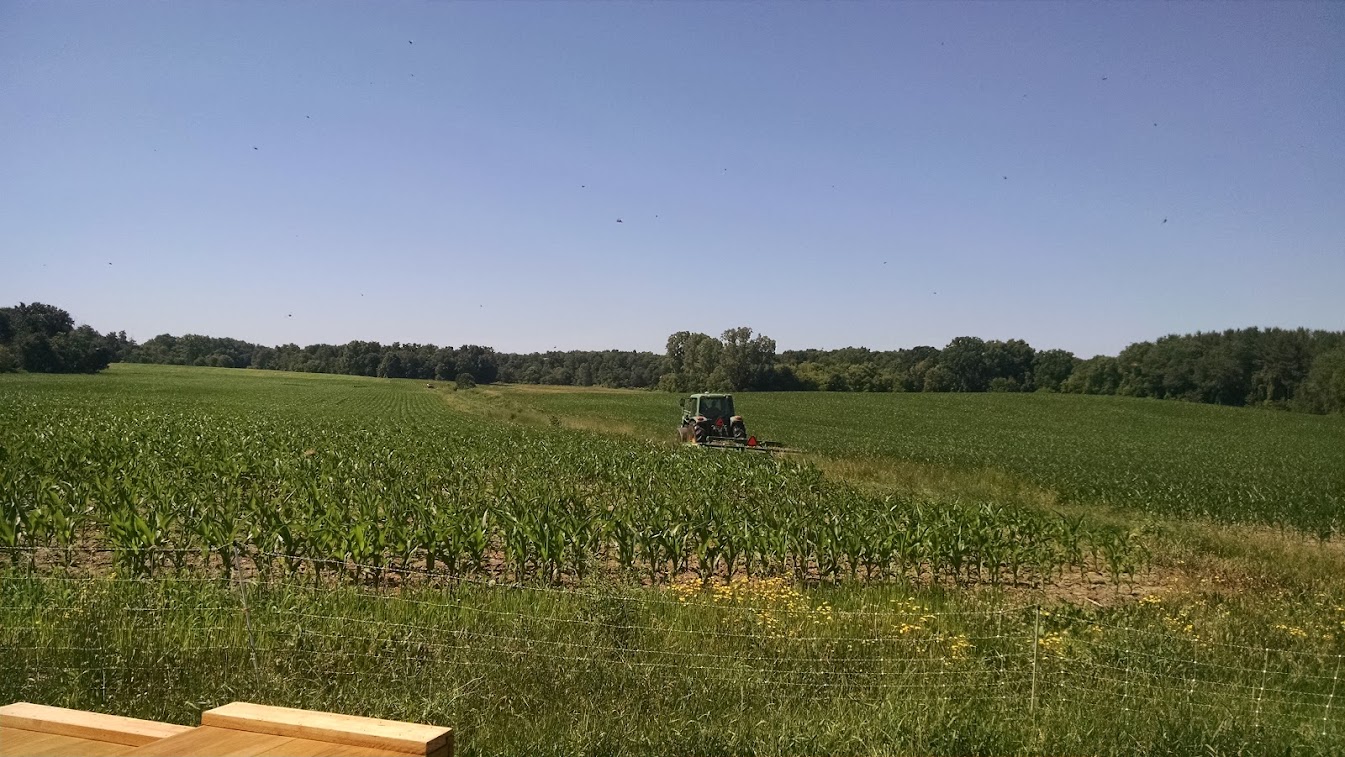
The property had previously been registered with the FSA and NRCS by the farmer/landowner, and Milbrath herself was already registered with the FSA for her beekeeping business. If it had been needed, however, she could have registered with these agencies during the initial visit. Next, she initiated paperwork to set herself up to be able to accept a federal grant by getting a DUNS number (a unique identifier) and registering through the federal System for Awards Management (SAM). She then submitted simple documentation indicating the landowner granted her the land decision and management permissions for the duration of the restoration effort. There were still many hours put into filling out paperwork and fixing tiny details along the way. Milbrath stuck through the administrative frustrations and learned much through the intimidating process. Being able to share her experiences with this process, she hopes to help others navigate through the system.
2016
Site preparation
Before seeds were purchased and planted, the site had to be prepped. On disturbed land, it is crucial that native seeds have contact with bare soil so that new plants can establish roots quickly and become established before being overrun by non-native plant species. Because the site had previously been farmed with herbicide-resistant crops, there were few invasive plants, and no tough grasses to contend with. There were mostly non-aggressive annuals and biennials like ragweed and docks. A few patches of more difficult invasives persisted, such as Canada thistle and reed canary grass in the wet area, as that site bordered a neighbor’s property that was unmanaged and dominated by those two species.
The preparation in the sandy area was easy. Because it was so dry and sandy and had recently been cropped, there were very few plants to compete with the native seeds. Weeds were sparse, and the site was already mostly bare soil. The only preparation needed was a burn in the spring (March 2016) prior to planting to rid the site of biomass to allow the seeds effective soil contact. Milbrath had prior experience burning, and the site has very safe breaks (it is surrounded by a creek on two sides), so she was able to conduct the burn with the help of friends.

The wet parcel had the tougher invasive plant species and more overall plants, so more preparation was needed. The site was too wet to plant or work in the spring of 2016, so Milbrath waited until late summer and fall to prep and planned on a winter planting. Milbrath disced the site in August, waited for weeds to appear, and then disced again. In late fall, while plants were still active, a broad-spectrum herbicide was applied. Winter thunderstorms saturated the soil however, which made the area too wet to plant in late winter and spring of 2017.
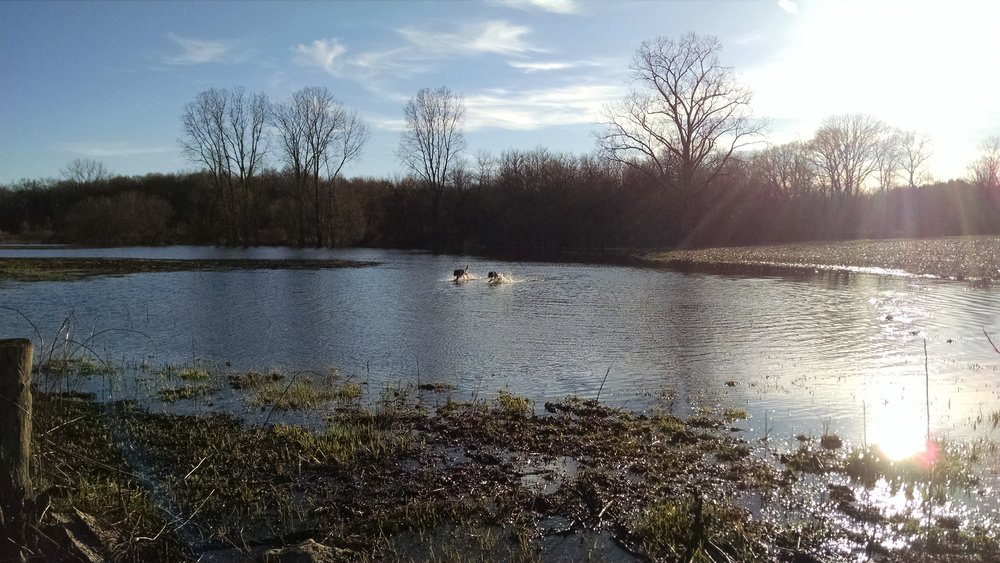
Seed selection
After months of paperwork, in May 2016, a project highlight finally came: seed selection. Milbrath contacted many businesses in hopes of finding the perfect fit, and she ultimately decided to work with Heartland Restoration Services and Earth Source. Both companies were based in Fort Wayne, Indiana, and they had a large stock of seeds from Michigan. They also had local genotypes for her area and indulged her with discussions on all planting options and the opportunity to hand pick the pollinator mix. While pre-made seed mixes can work for some, Milbrath had extreme soils (sand and muck) that needed a pickier seed choice, and she wanted a lot of different forbs to support many different pollinators. Each site would require a separate mixture to accommodate for the vastly different soil types, while still providing season-long bloom and thus a pollen source for pollinators all season.
For the sandy area, a short grass/scrub prairie was intended. With the help of Heartland Restoration, Milbrath decided on 3 pounds per acre of grasses and 2 pounds per acre of a flower mix. At $550 per acre, the mix was quite expensive but within the budget provided by NRCS. This mixture would end up being 37% native grasses and 63% native forbs, all of which would greatly benefit many pollinators. The NRCS EQIP program required a minimum of four different forb species for the site, but it did not have a maximum, so Milbrath chose 16 different forb species and two grasses.
The mucky wet area’s seed mix would need to accommodate the drastic difference in the soil. The plants would have to be either wetland-based or could handle “having their feet wet,” meaning that the roots could tolerate wet areas. The seed mix was 68% grasses/sedges/rushes and 32% forbs. Milbrath discussed planting methods with the seed company, so they could package seeds appropriately. Because she planned to use a broadcast planter, large seeds like Silphium perfoliatum and Asclepias incarnata were kept out of the mix and shipped in separate bags for later hand seeding.
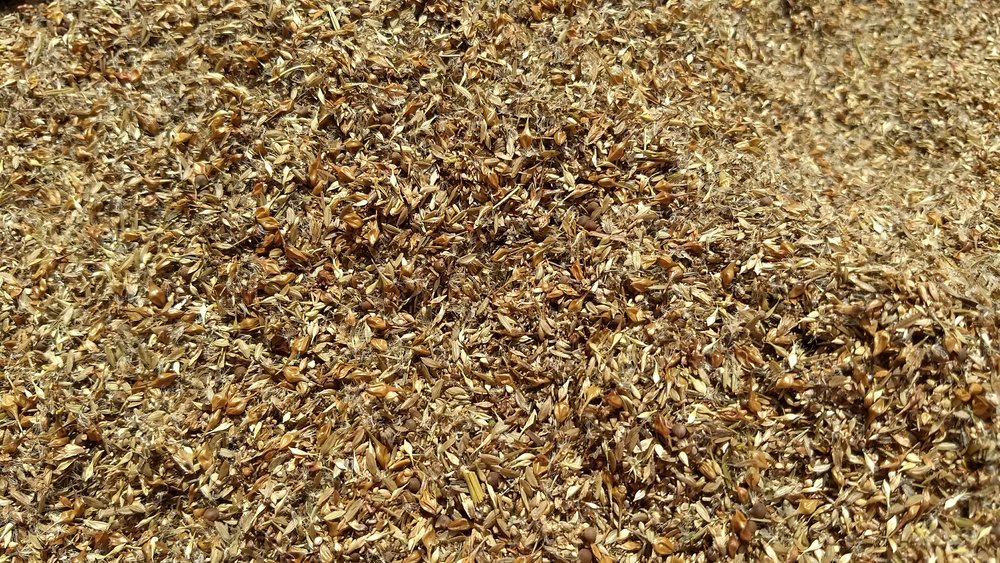
Planting
The planting began in early June 2016 on just six acres of the sandy site. The wetland was still too wet to plant, and due to a miscommunication, part of the sandy parcel (about two acres) was planted in corn, before the seed was purchased. At the recommendation of the seed company, Milbrath purchased a small chest freezer and stored the seeds frozen until they could be planted. Freezing the seeds prevented moisture, rodents, or other pests from ruining the very expensive seeds before they could be planted. An exemption was filed with the NRCS with plans to finish planting in 2017.
Milbrath had access to the farming equipment and was able to borrow a tractor, cultipacker, and alfalfa broadcast seeder from the farmer, saving her the cost of renting. The planting process on the sandy soil began with driving a cultipacker over the whole area to ensure the ground was firm and to help pack down the soil. Prairie seeds can be placed too deep at times, which prevents them from flourishing. The cultipacker was useful on the very loose sandy soil to prevent the seeds from going too deep. Because the native plants take so long to establish, it was recommended that a cover crop be included in the mix for year one. Milbrath looked for seed oats, but was unable to find them, so instead purchased bin oats (about a bushel per acre). The oats were spread over the area in one pass using an alfalfa seed spreader. Very few of the oats actually came up (due to a drought after planting), and because there was so little weed pressure, Milbrath now feels that the oats were probably unnecessary, even in the very loose soil on their site. The spreader was re-calibrated, and the dry-site prairie seeds were added.
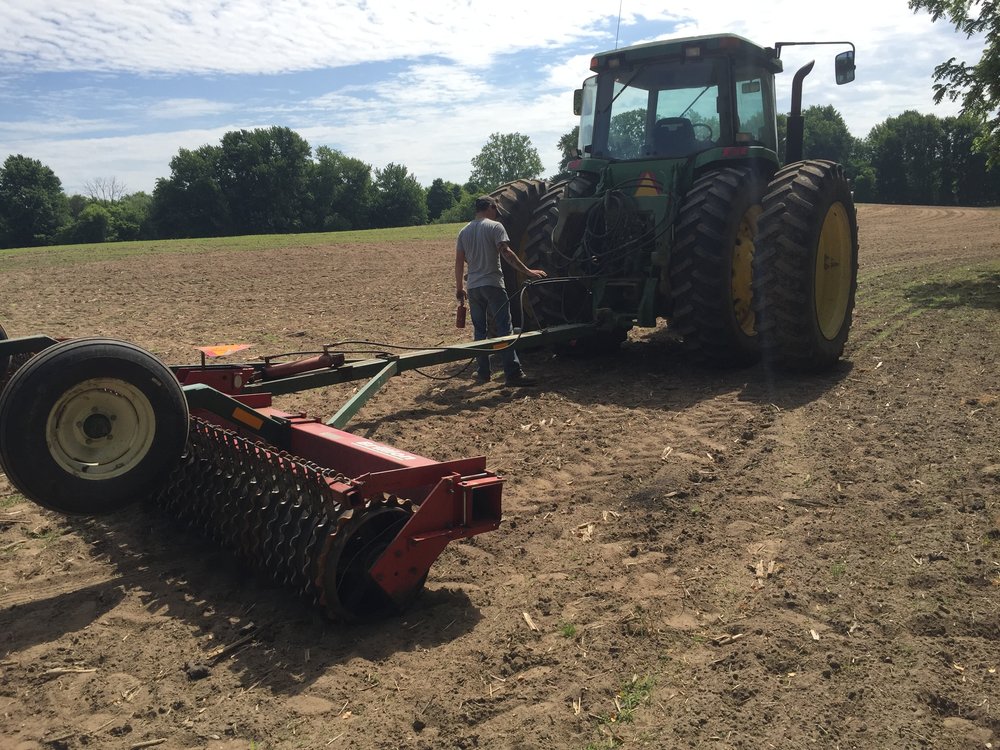
Milbrath made two passes over the site – she planted half of the seeds going north-south and the second half going east-west, mixing them halfway through to ensure an even broadcast of the differently-sized seeds. Once the seeds were completely spread, a second run with the cultipacker was done to press the seeds into the ground to prevent the wind from blowing them away.
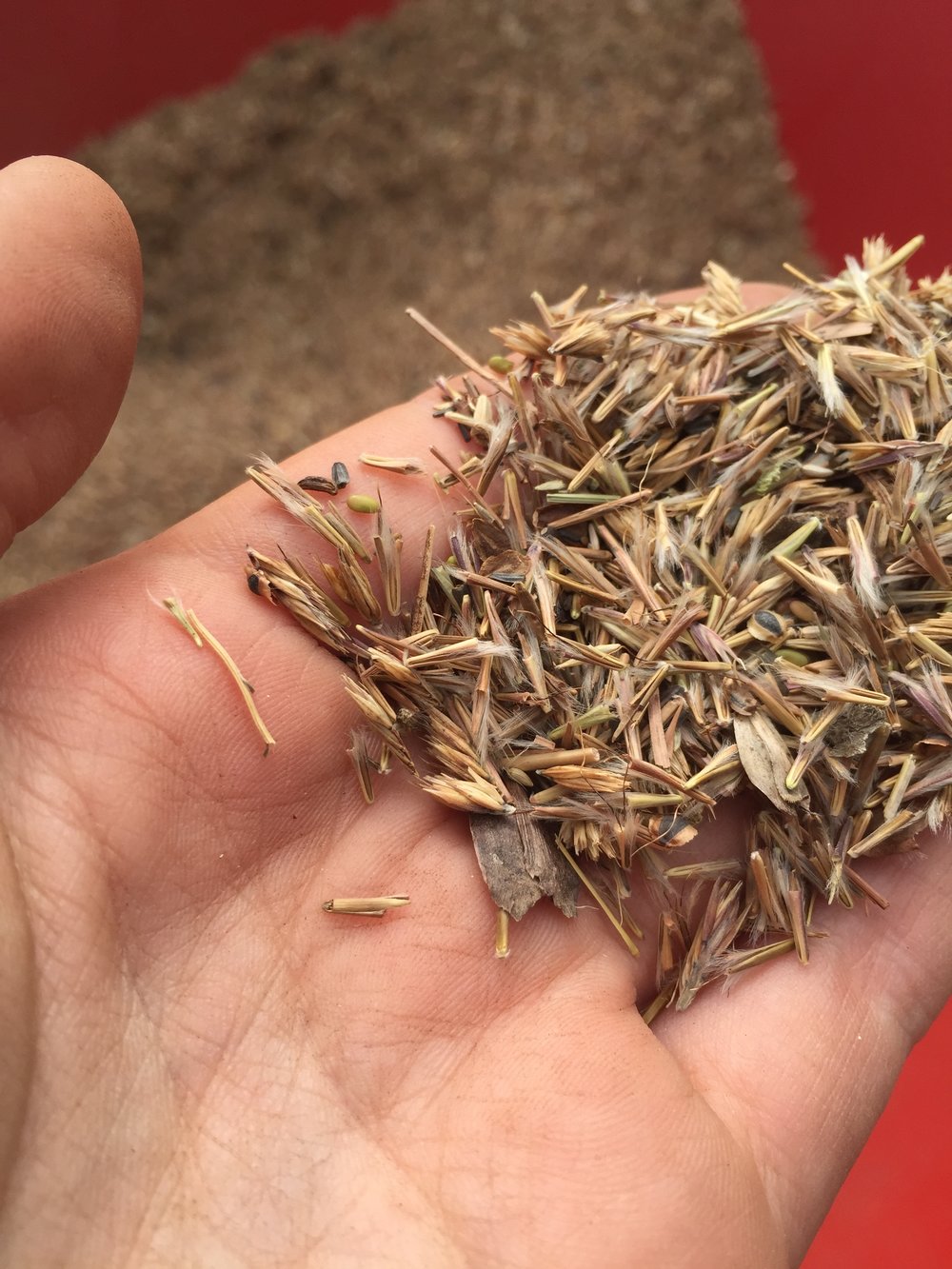
2017
After the exemption was approved, the rest of the sandy area was planted in June 2017 in the same fashion as the year prior, but without the addition of the oat cover crop. The two sections of the sandy prairie that were planted at two different years and times of year had two very different plants that dominated, even though the same seed mix was used. Milbrath likes this diversity and will likely stage multiple plantings in further projects where possible to promote this patchiness in other areas.

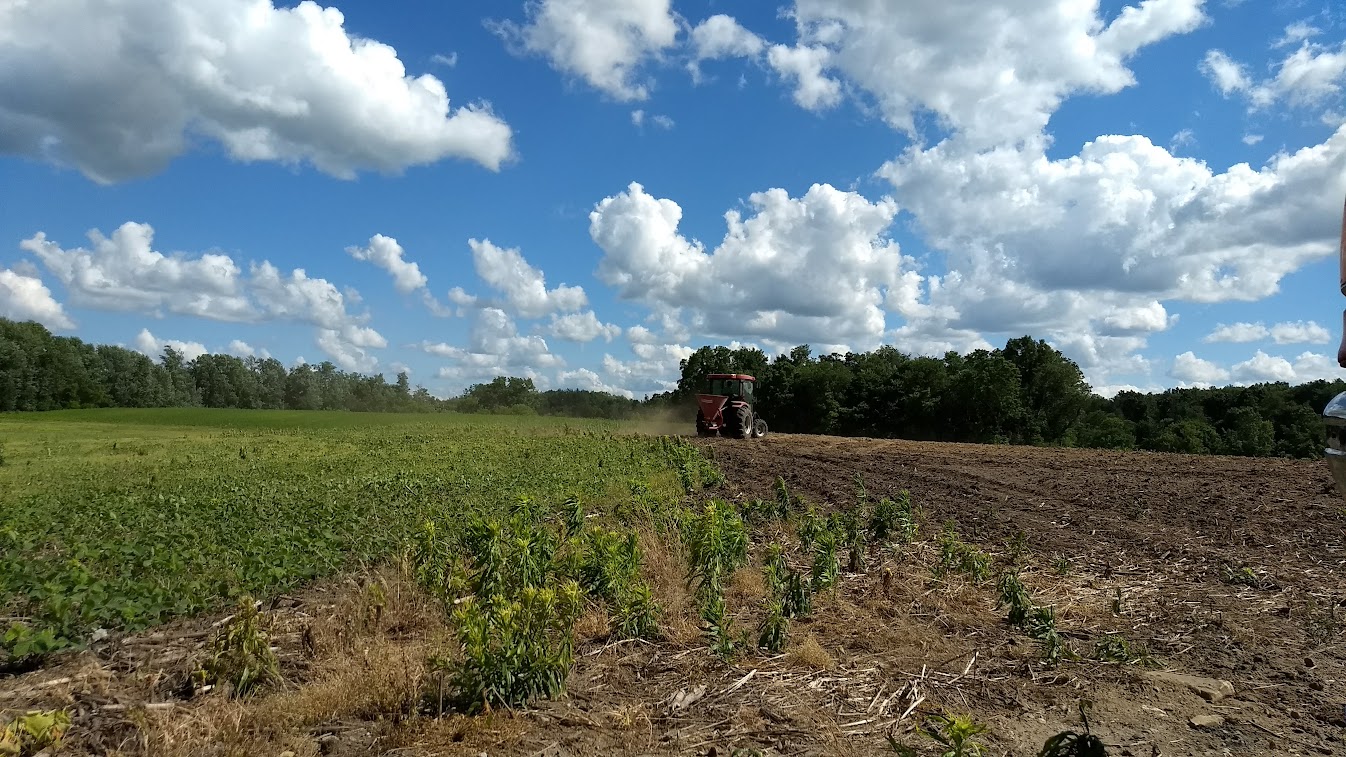
The wet area finally dried out in early June only for Milbrath to discover very tall weeds in place of the water. She disced two more times and sprayed the herbicide once again by communicating with the farmer to have the site sprayed when the rest of his field was sprayed. While the sandy site had few weeds of concern, this site was bordered by two very difficult invasive species – reed canary grass and Canada thistle – so site prep was more extensive. Finally, the soil was suitable for planting the end of June. With less diverse seed sizes, Milbrath was able to load the hopper with all the seeds and spread them over the whole area at once. The Silphium perfoliatum (cup plant) and Asclepias incarnata (swamp milkweed) seeds that were packaged separately were hand dispersed by walking along the area and letting the wind take them.

In 2017, some plugs were added, provided by a friend who was a pollinator supporter and native plant enthusiast. There was no way to get water to the site, so the planting of the plugs were timed to get rain within the first few days of establishment. While plugs are too expensive to use to cover the large area, Milbrath plans to continue to use them to add diversity to the site once it is established.

Establishment
The goal of the first few years of a planting is to allow the native plants to establish deep roots without getting completely shaded out. This goal meant that the site had to be brush hogged when the weeds got above knee height. For the first two years (2016 and 2017), little maintenance was needed; with the dry summers, brush hogging was only needed once in early September. If the summers had been wetter, the site may have required multiple cuts. In the spring of 2018, the biomass was burned off from the sandy site because it had filled in with grasses that were thick enough to impede seedling growth.
In the first few years, very few of the native plants were visible. Milbrath had added Rudbeckia hirta (black-eyed Susan) to the mix, specifically because it is known to bloom in the first year after planting and can provide hope that the planting was successful. With thousands of dollars of seeds in the ground, it can be stressful to wait years to know if the project was successful. While some seedlings were visible in the first few years, the sandy site was quite bare, and dominated by marestail, ragweed, and some grasses.
By 2020, all of the native plants in the seed mix had been identified, and the site was completely dominated by native plants. It took until 2022 for some of the plants like Silphium lactinatum (compass plant) to flower. Other natives that were not in the mix, such as Asclepius syrica (common milkweed) and various goldenrod and asters also started to appear over the years.
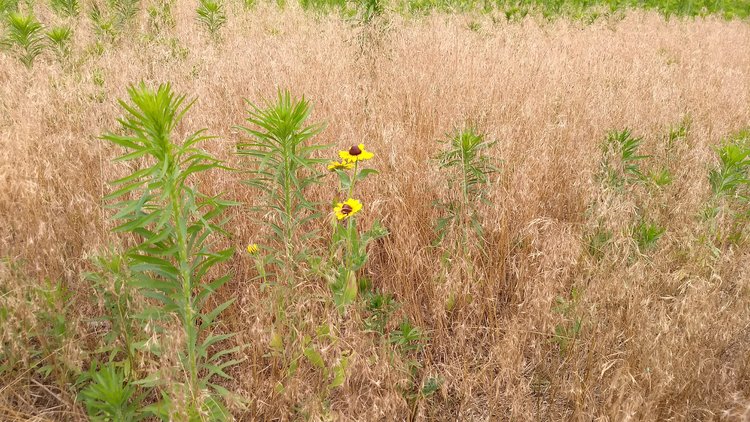
Once the native seeds established, the goal of maintenance turned to prevention of invasive species and woody plants, which can be done with prescribed burns. The frequency of burns needed depends on the soil and invasive plant pressure in the area. In 2022 the sandy site still has effectively no invasive species but has a few small woody plants like boxelder seedlings and berry brambles, and the wetland site is starting to show larger patches of Canada thistle and reed canary grass. A burn will be useful soon.
Milbrath is working with the NRCS office again to get funding to support a larger burn for these areas for 2023. She is also working with the NRCS to do invasive species management on the small woodlot in the center of the site, and to do riparian restoration along the creek that borders the property. Because she works full time, she plans on only applying for one project at a time, to give her the time for the paperwork, planning, and implementation.
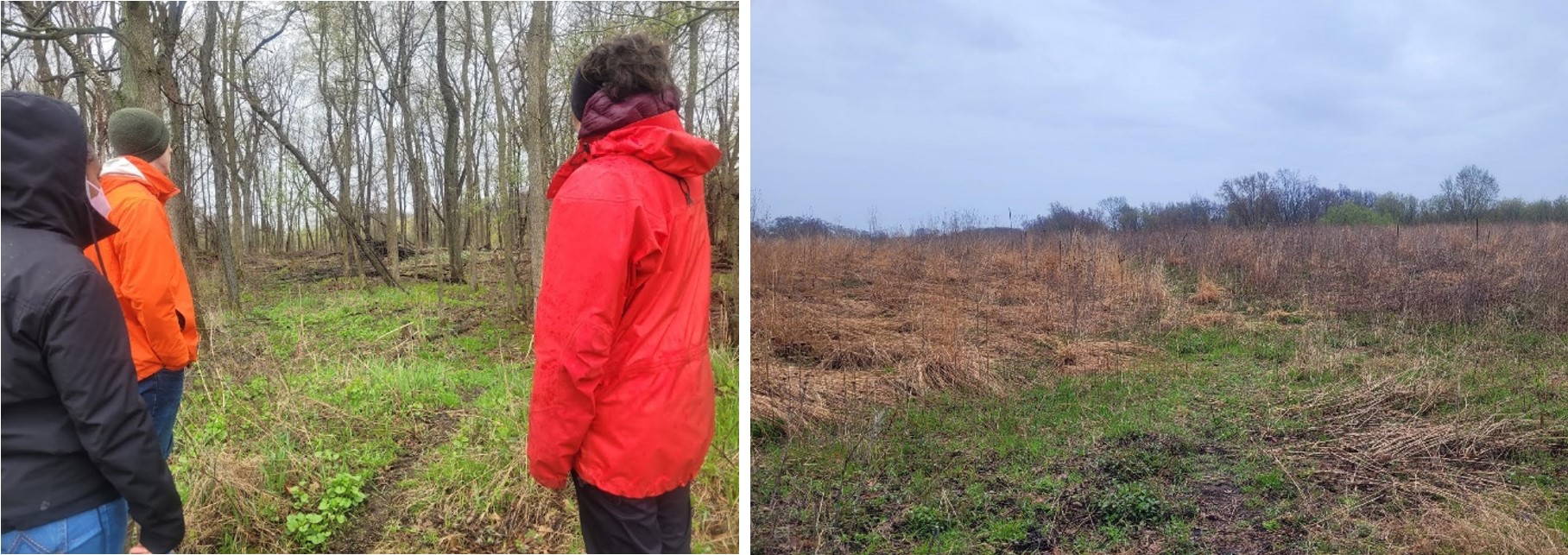
Milbrath stresses the idea of making a better habitat rather than a perfect habitat. For example, she believes she will always have troubles with invasives in the wetland site, specifically Canada thistle and reed canary grass, due to their surrounding abundance on neighboring properties. In general, however, the habitat is ‘better’ overall; there is much more diversity, and many more flowers for pollinators. She will keep the invasives at bay in a reasonable manner with brush hogging and burns. She is planning on only burning patches of the site and estimates she will have to burn each part every five years or so. To increase diversity on the site, she has added plugs from her partnership with Project Wingspan, and occasionally spreads seeds that she has collected from other nearby sites.
Reflections
Overall, Milbrath is thrilled with the process and the site. She has seen many more birds there, including rare species, and she enjoys watching the honey bees and native bees on the native flowers. The landowner is pleased as well. The site is not a major source of weeds for the field, and he has made income by renting it out to both deer and turkey hunters. The site has already given back – since the plants are established, the seeds can be used for other projects. Milbrath collects seeds for neighboring farmers to use in their projects, and in 2020 and 2021 partnered with the U.S. Fish and Wildlife Service’s Project Wingspan program to work with volunteers to collect native seeds from the site. These seeds are used to support other restoration efforts throughout the area to promote land for butterflies and other pollinators.
Having access to tractors and equipment from the farmer throughout the process made the planting and upkeep significantly easier. Because of her past habitat restoration experience, Milbrath was also able to do the burns on her own, adding to the ease. If she had to rent tractors and pay for the burns, the grant would still have covered most of the costs but at the expense of a less luxurious seed selection. She stresses that the paperwork was much more time consuming than anticipated despite already being associated with the FSA. Looking back, however, Milbrath says the frustrations were worth it. Due to the delays in planting, storing such expensive seeds for a length of time was unsettling but ultimately ended up being fine.
Milbrath stresses the idea that plans and timelines will change. She urges others to have patience and trust the process as the results are worth it. The first year of planting in 2016 resulted in no visible plants. The following year there were confirmed natives, but still in smaller numbers. By 2018, that number increased even more and continues to look better with each coming year. It takes time for the new plants to put down roots and thrive. Even still in 2022, Milbrath continues to work with NRCS on more projects to expand the habitat transformation. Over time, these new native plants have become a refuge for pollinators and an astounding habitat to see.
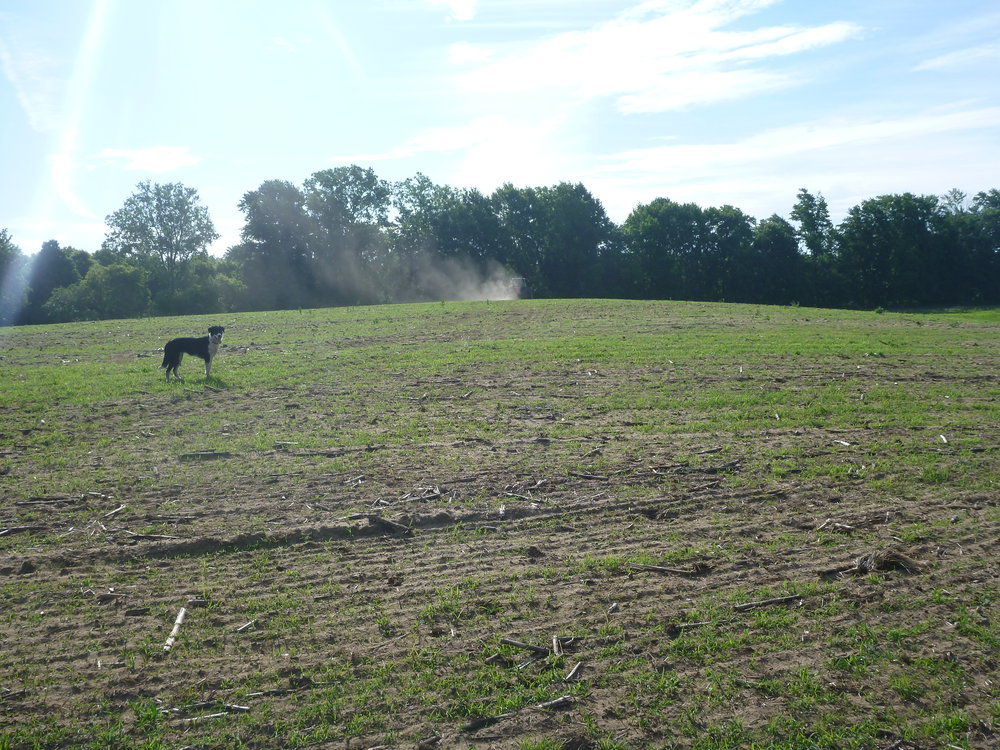
Bees and beneficial insects comprise the world’s hardest-working workforce. With over 450 species of bees in Michigan, creating a diverse habitat that helps them thrive and will have far-reaching impacts on our state.
Previous articles in series
- USDA funds available to establish pollinator habitat on your land
- Somewhere for the pollinators to go: A case study of establishing large-scale pollinator habitat
- Pocket of paradise: A second case study of establishing large-scale prairie planting
Acknowledgment
Thank you to the Michigan Department of Agriculture and Rural Development for securing funding from the U.S. Environmental Protection Agency for Michigan State University to implement strategies in the Michigan Managed Pollinator Protection Plan.



 Print
Print Email
Email